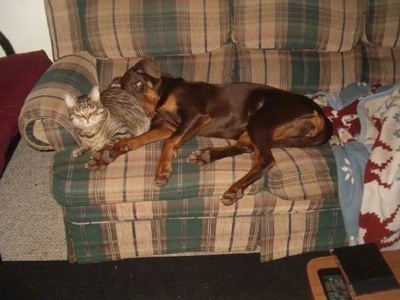Dancing Doberman disease (DDD or Distal Polyneuropathy) - also known as Dancing Doberman Syndrome - is a disease only seen in Doberman dogs, primarily affects their gastrocnemius muscle. A simple description of DDD is one of a progressive disease, usually first involving the holding up of one rear leg while the dog is standing. Over several months the condition advances with a wasting of the rear leg muscles and a more constant shifting of weight on the rear legs that resembles a dog "dancing". Frequently these dogs will knuckle over with their rear paws and ultimately prefer to sit or lie down rather than stand. No known cause of this disease and the presumption that genetics must play a role in this syndrome. The disease is similar to hereditary sensory and autonomic neuropathies in humans. In some cases, there is a sensation of burning soles or discomfort with pressure on the feet. A similar sensation might cause constant lifting of the feet in dogs with Dancing Doberman Disease.Dancing Doberman Disease symptoms normally appear when the dog is 6-7 months old, but the age of onset can vary from just 4 months to up to 10 years. Both males and females are affected. Most affected dogs have normal findings on other tests, including blood counts, biochemistry, x-ray, and thyroid function. When the dog is standing, one of its rear legs will suddenly flex. Over the course of the following months, the problem will usually start affecting the other hind leg as well. A dog with Dancing Doberman Disease can end up alternatively flexing and extending each rear leg and this behaviour is the reason behind the name of this health problem. Many dogs will start knuckling over their rear paws and some dogs will eventually avoid standing all together; they will prefer to lie or sit. They can however still be perfectly capable of running around. There is no signs of pain associated with Dancing Doberman Disease.  Dancing Doberman Disease can mimic many other conditions such as lumbosacral disc disease, cervical vertebral instability (CVI), inflammation of the spinal cord, spinal arthritis, cauda equina syndrome, some nervous system maladies, and spinal tumors. Hyperactive tendon and muscle reflexes with gastrocnemius muscle atrophy are early clinical signs, followed by more extensive pelvic limb muscle atrophy as the disease progresses. Proprioceptive deficits are seen occasionally. It is likely the condition is more prevalent than previously recognized because there is a general lack of awareness on the part of veterinarians and breeders, and therefore, the condition is often overlooked as a diagnosis. On different diagnosis, lumbosacral stenosis, intervertebral disc disease, and discospondylitis of the lower lumbar spine are usually painful. Also neoplasia of the lumbar spinal cord or nerve roots progresses more rapidly and can be painful. At the moment, there is no know cure or treatment for Dancing Doberman Disease. On the positive side, most dogs with DDD live to be as old as any other Doberman and the condition appears to be completely painless for the dog. A majority of the affected dogs can still walk. Dancing Doberman Disease is however a progressing disease that will cause increasingly weak legs and muscle atrophy.

No comments:
Post a Comment